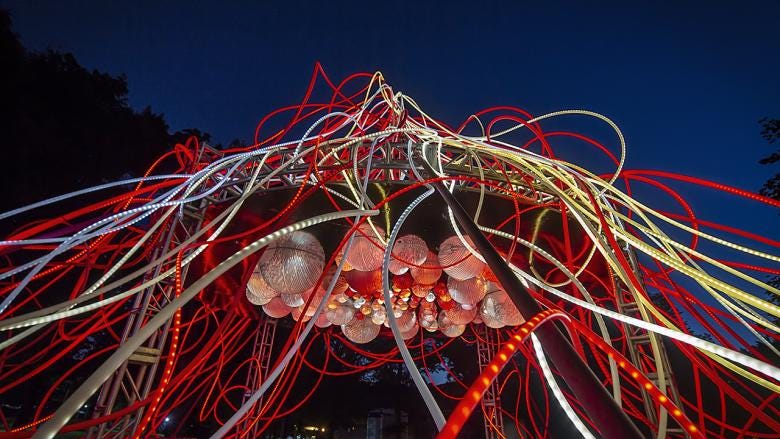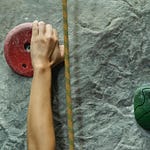Light Sculpture by Grimanesa Amoró
Many people who come to Holistic Yoga and Somatic classes are working with the life challenge of chronic pain, chronic stress or a chronic health condition. I find that teaching yoga to people who don’t feel in tip-top mental or physical health is both deeply gratifying and a great honour.
We work in smaller groups, and there is an invitation to co-create the class, to learn from each other. This promotes a sense of connection and community. We use the full range of yogic tools in our quest to create more balance and harmony both within ourselves and within the group. This type of yoga is not about competition, or striving to “nail” a particular pose.
Instead of achievement, we focus on cultivating qualities that enable us to live life in such a way that we cause as little harm to ourselves, others and the planet as we are able. We learn to regulate our nervous systems, and we learn to be mindful. In my thirty-five years of yoga practice and nearly twenty years of yoga teaching, I’ve come to realise that healing cannot occur through movement practice alone, we must pay mindful attention.
What is Mindfulness?
Mindfulness is a word that is bandied about a lot these days, yet we often give little thought to the deeper meanings of the word. Here is one of my favourite definitions of mindfulness. Please note, there are other definitions, we can explore them in future articles…
“Mindfulness in a general sense is about waking up from a life on automatic and being sensitive to novelty in our everyday experience.”
Daniel J. Siegel - The Mindful Brain
For me, Daniel Siegel’s definition is fun, inspiring and very relevant to mindful movement in yoga practice and every day life. Our bodies work principally on auto pilot, which might be described as “a cognitive state in which we act without awareness”. (Free Dictionary)
The common example is the experience of driving home from work, only to realise (once you’re home) that you have almost no recollection of any aspect of the journey. Your body got you there on autopilot, whilst your mind was free to think of things like the to do list, a problem at work or your concern about relative or friend.
Pros and Cons of Auto Pilot
Auto pilot is amazing useful and frees up our brain to plan for the future or reflect upon the past. These non-mindful cognitive processes are essential for our wellbeing and development as human beings. However, when we spend most of our waking hours in future or past focussed, autopilot mode, then both our body and mind suffer.
When we rely on our habitual movement patterns to get us through he day, we have little awareness of how we are using our physical body. If we pay no attention to how we walk, sit, stand, lift, reach and balance then our body tends to default to the easiest and most energy conserving way of doing these things. The problem is that the body decides what is most energy conserving movement choice in the present moment. What is more, it doesn’t consider the long term consequences.
In the body’s rationale, the most efficient way of doing something, is the way you always do it. There is no need to switch out of autopilot and flood the sensory-motor nervous system with lots of new information. Coming out of autopilot is mentally demanding and tiring for the nervous system, which is why we don’t usually do it!!
Rewiring Our Samkaras
However, if we do things the way we’ve always done them, we are at the mercy of our samskaras. Samskaras are physical and mental impressions, psychological imprints that are made upon our panchamayakosha (our mind-body-spirit). The physical manifestation of samskaras are increases in muscle tension in certain areas of the body due to an injury, ongoing stress, or even an emotional event. Life leaves myriad impressions on our tissues in this way and this leads to imbalances, which have the potential to create further injury and stress.
When we are on autopilot we move in a habitual way which includes all the compensations that we make to protect the vulnerable areas of our bodies.
Examples of compensations:Shifting our weight onto one leg to protect an old injury that has healed;
Suppressing mental annoyance at a colleague at work, so it manifests as an actual pain in the butt; and
Rounding our shoulder inwards to protect from an unresolved past harm, hurt or fear.
Mindfulness helps us to shine a light on these samskaras. It is a key aspect of therapeutic yoga, which seeks to illuminate these unconscious holding patterns and re-wire them in a different way that off-loads the stress that is placed upon our our whole being. This stress can cause very physical problems such as intervertebral disk bulging and prolapse, arthritis of the hip joint (or any other joint) and chronic neck or shoulder pain.
Chronic Pain - Seeking Help
Of course, ongoing pain, must be assessed and if necessary treated by a medically trained professional. Sometime surgery is needed. Hip, knee and even some spine operations, can be incredibly transformative. Sometimes a period of time on pain killing medicine is needed to kick start the healing process. However, in many cases, healing can occur if we are able to a) find out what habitual movement patterns are leading to the discomfort and b) change them.
Attention Brings Illumination
Yoga and somatics, practiced slowly with full attention to body sensations such as stretch, weight, tension, pressure, heat and vibration, can illuminate the areas of the body that are dull and unresponsive. In somatics we call these areas patches of Sensory-Motor Amnesia (S-MA) for short. This is where the brain has stopped talking to the muscle fibres.
In order to find these patches of sensory motor amnesia we have to pay full attention, to our movement. Once we have the movement clearly represented in our mind, then we become able to mindfully guide the process of reconnecting the areas of S-MA back online to the brain. This involves mindfulness: slow, focussed attention in the present moment, without judgement.
In yoga, we can direct our laser sharp clear attention onto body movement, breath, thought patterns, sensations and emotions. In this way we can assess and recalibrate the processes of both the sensory-motor system and the autonomic nervous system (the nerves that activate body processes that work when we are in action and when we are at rest). In this way mindfulness helps us to work specifically on areas of compression of tissues, but also more globally. The work on our autonomic nervous system help us to regulate, to create balance between activity and rest. As a consequence, yoga enables us to rewire our nervous system to create more health, resilience and balance in our body, mind and spirit.
Dear Reader,
I hope you enjoyed this article, let me know in the comments what you thought! Many of you in the UK will be celebrating the Queen’s Jubilee, or maybe just celebrating… Whilst all this merriment is going on I’m studying with my fellow yoga teachers on my incredible Yoga Therapy course. I’m so enjoying it (thankfully!)
So there is no Saturday class this week, and I feel I will be offering Saturday classes in a different way and also some alternative for those of you who find it difficult to make the live classes. Watch this space!
Next Saturday 11th of June I’m running an in-person workshop at One Yoga London called Empower your Spine. It is for people who practice yoga with ongoing back ache. This class will introduce you to lots of tips and ideas of how to make yoga safer, more comfortable and enjoyable if you have an achy back. It’s £30 but if you’d like a £5 discount then reply to this email and I will organise one for you!. It would be so fab to see you there!
With love and good wishes,
Julia













How to Rewire Unconscious Movement Patterns